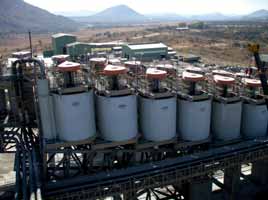
Minimizing Pit to Port investment risks through integral masterplanning
‘Pit to Port’ operations are widespread throughout the resource industry. Because coastal reserves deplete and demand increases, there is a general push towards inland reserves, increasing the distances between pit and port. The transport corridor, therefore, often becomes the main costs determining factor when initiating a Pit to Port mining operation.
Investing in Pit to Port mining operations has significant risks. The price levels of resources and shipping rates are volatile and other economic, political, legal, institutional, environmental and social variables are subject to change, especially in developing countries. These variables all affect the overall feasibility of a mining and export operation. Therefore, the total cost of ownership of a complete Pit to Port operation is difficult to estimate up front. Together with the unpredictability of the actual mine production, there is a big financial risk for investors.
Due to this financing risk it is often inevitable that mining operations start relatively small (low CAPEX). The choice for a Pit to Port transport modality (e.g. road, rail, inland waterways or belt conveyor) and the type of port operations are therefore also dictated by the available investment budget. Later on, if the mine production increases, the transport and port operations are up-scaled in parallel. For example: by driving more trucks over a hauling road. In the long term, this approach may not be optimal from a total cost of ownership or total profitability perspective, but it does pose the lowest risk and is therefore easiest to finance. However, at a certain mine production level a switch to a different modality may significantly increase the long- term profitability; this logistical re-evaluation is often not possible or overlooked because mining, transport and port operations have not been designed integrally.
There are numerous Pit to Port mining operations worldwide which have ‘outgrown’ their initial concept and therefore have sub optimal profitability. A few typical examples:
- The sunk costs into the continuous upgrading of the hauling road and increasing truck numbers make switching to another modality unattractive halfway the operational life of a mine. However the OPEX of this type operation are very high when compared with an overland conveyor for the same annual throughput.
- Limited space for stockyard expansion necessary to cope with increased annual throughput and larger vessels.
- Jetty upgrade and expansion which is necessary to cope with increased vessel sizes and loading rates conflicts with the ongoing export operations. This results in a sub-optimal expansion solution.
To avoid issues of this kind, it is essential that an integral masterplan is made during the initiation phase which incorporates the envisaged capacity increases throughout the complete supply chain and also takes all significant risks into account (resource price levels, socioeconomic variables etc.).
This ensures that no decisions are made during start-up which will be difficult to correct later on. This masterplan is a critical part of the bankable feasibility study. A bankable feasibility study of this magnitude includes bankable cost estimate of several alternatives/scenarios for the realization and operation of the mine, the processing plant, the inland transport and the port operation.
Ideally this approach results into a pit to port operation which can be scaled to the actual production, has manageable risks and near-maximum profitability throughout its life span. It is this solution which has the highest expected return when investments costs are corrected for risks.
As worldwide consultancy and engineering service provider, Royal HaskoningDHV is experiencing an increasing demand for integral supply chain services. Therefore, Royal HaskoningDHV has combined its experts throughout the supply chain and the economical and environmental experts, resulting in newly branded Pit to Port services. With these services, the company is positioning itself as project enabler in both financial and technical terms. RHDHV can perform complete and comprehensive Pit to Port projects from the initiation phase through design, tendering, realization and completion:
- logistic analysis;
- financial modelling;
- market analysis;
- masterplanning;
- open pit and underground mining;
- mineral processing;
- materials handling;
- rail transport;
- inland waterways;
- hauling roads;
- port development;
- dry bulk terminals;
- coastal engineering;
- sea shipping;
- electrical power generation and distribution; and
- environmental and social impact assessment (ESIA)
This ‘one-stop-shop’ approach of a Pit to Port project ensures that the complete mineral supply chain can be tailored towards the client’s wishes (e.g. lowest investment cost vs. lowest life cycle costs). RoyalHaskoningDHV’s global presence allows it to incorporate local knowledge and to have transparent and efficient communication.
Successful merger
Due to the recent merger of Royal Haskoning and DHV into Royal HaskoningDHV, the capabilities of two established companies have been combined. The two former companies complement each other well in expertise and geography and the added scale allows Royal HaskoningDHV to bid for larger projects as well. Royal HaskoningDHV is now the largest privately owned engineer/consultancy firm in the Netherlands and is in the top 10 worldwide. Royal HaskoningDHV has a broad portfolio of expertise and covers, amongst others, aviation, buildings, industry, energy & mining, infrastructure, maritime & waterways, planning & strategy, rivers, deltas & coasts, transport & asset management, and water technology.